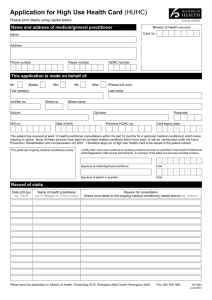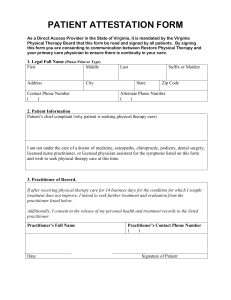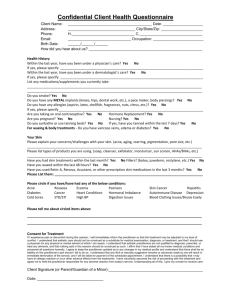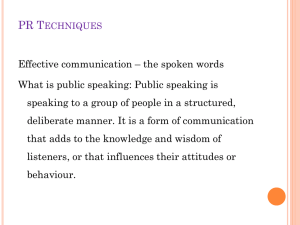Iowa Unified ECE/ECSE Endorsement (ED100) Iowa Renaissance Licensure/Interstate New
advertisement
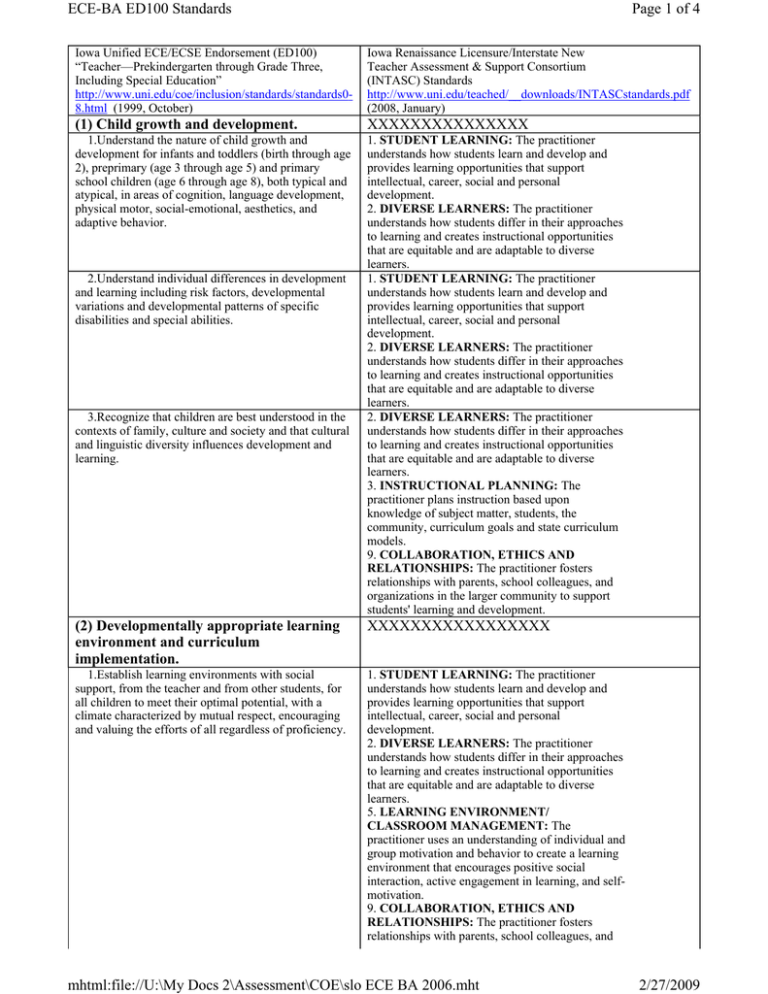
ECE-BA ED100 Standards Iowa Unified ECE/ECSE Endorsement (ED100) “Teacher—Prekindergarten through Grade Three, Including Special Education” http://www.uni.edu/coe/inclusion/standards/standards08.html (1999, October) Page 1 of 4 Iowa Renaissance Licensure/Interstate New Teacher Assessment & Support Consortium (INTASC) Standards http://www.uni.edu/teached/__downloads/INTASCstandards.pdf (2008, January) (1) Child growth and development. XXXXXXXXXXXXXXX 1.Understand the nature of child growth and development for infants and toddlers (birth through age 2), preprimary (age 3 through age 5) and primary school children (age 6 through age 8), both typical and atypical, in areas of cognition, language development, physical motor, social-emotional, aesthetics, and adaptive behavior. 1. STUDENT LEARNING: The practitioner understands how students learn and develop and provides learning opportunities that support intellectual, career, social and personal development. 2. DIVERSE LEARNERS: The practitioner understands how students differ in their approaches to learning and creates instructional opportunities that are equitable and are adaptable to diverse learners. 1. STUDENT LEARNING: The practitioner understands how students learn and develop and provides learning opportunities that support intellectual, career, social and personal development. 2. DIVERSE LEARNERS: The practitioner understands how students differ in their approaches to learning and creates instructional opportunities that are equitable and are adaptable to diverse learners. 2. DIVERSE LEARNERS: The practitioner understands how students differ in their approaches to learning and creates instructional opportunities that are equitable and are adaptable to diverse learners. 3. INSTRUCTIONAL PLANNING: The practitioner plans instruction based upon knowledge of subject matter, students, the community, curriculum goals and state curriculum models. 9. COLLABORATION, ETHICS AND RELATIONSHIPS: The practitioner fosters relationships with parents, school colleagues, and organizations in the larger community to support students' learning and development. 2.Understand individual differences in development and learning including risk factors, developmental variations and developmental patterns of specific disabilities and special abilities. 3.Recognize that children are best understood in the contexts of family, culture and society and that cultural and linguistic diversity influences development and learning. (2) Developmentally appropriate learning environment and curriculum implementation. XXXXXXXXXXXXXXXXX 1.Establish learning environments with social support, from the teacher and from other students, for all children to meet their optimal potential, with a climate characterized by mutual respect, encouraging and valuing the efforts of all regardless of proficiency. 1. STUDENT LEARNING: The practitioner understands how students learn and develop and provides learning opportunities that support intellectual, career, social and personal development. 2. DIVERSE LEARNERS: The practitioner understands how students differ in their approaches to learning and creates instructional opportunities that are equitable and are adaptable to diverse learners. 5. LEARNING ENVIRONMENT/ CLASSROOM MANAGEMENT: The practitioner uses an understanding of individual and group motivation and behavior to create a learning environment that encourages positive social interaction, active engagement in learning, and selfmotivation. 9. COLLABORATION, ETHICS AND RELATIONSHIPS: The practitioner fosters relationships with parents, school colleagues, and mhtml:file://U:\My Docs 2\Assessment\COE\slo ECE BA 2006.mht 2/27/2009 ECE-BA ED100 Standards 2.Appropriately use informal and formal assessment to monitor development of children and to plan and evaluate curriculum and teaching practices to meet individual needs of children and families. 3.Plan, implement, and continuously evaluate developmentally and individually appropriate curriculum goals, content, and teaching practices for infants, toddlers, preprimary and primary children based on the needs and interests of individual children, their families and community. 4.Use both child-initiated and teacher-directed instructional methods, including strategies such as small and large group projects, unstructured and structured play, systematic instruction, group discussion and cooperative decision making. 5.Develop and implement integrated learning experiences for home-, center- and school-based environments for infants, toddlers, preprimary and primary children: ·Develop and implement integrated learning experiences that facilitate cognition, communication, social and physical development of infants and toddlers within the context of parent-child and caregiver-child relationships. ·Develop and implement learning experiences for preprimary and primary children with focus on multicultural and nonsexist content that includes development of responsibility, aesthetic and artistic development, physical development and well-being, cognitive development, and emotional and social development. ·Develop and implement learning experiences for infants, toddlers, preprimary, and primary children with a focus on language, mathematics, science, social studies, visual and expressive arts, social skills, higherthinking skills, and developmentally appropriate methodology. ·Develop adaptations and accommodations for infants, toddlers, preprimary, and primary aged children to meet their individual needs. 6.Adapt materials, equipment, the environment, programs and use of human resources to meet social, cognitive, physical motor, communication, and medical needs of children and diverse learning needs. Page 2 of 4 organizations in the larger community to support students' learning and development. 7. ASSESSMENT: The practitioner understands and uses formal and informal assessment strategies to evaluate the continuous intellectual, social and physical development of the learner. 3. INSTRUCTIONAL PLANNING: The practitioner plans instruction based upon knowledge of subject matter, students, the community, curriculum goals and state curriculum models. 4. INSTRUCTIONAL STRATEGIES: The practitioner understands and uses a variety of instructional strategies to encourage students' development of critical thinking, problem solving, and performance skills. 1. STUDENT LEARNING: The practitioner understands how students learn and develop and provides learning opportunities that support intellectual, career, social and personal development. 2. DIVERSE LEARNERS: The practitioner understands how students differ in their approaches to learning and creates instructional opportunities that are equitable and are adaptable to diverse learners. 3. INSTRUCTIONAL PLANNING: The practitioner plans instruction based upon knowledge of subject matter, students, the community, curriculum goals and state curriculum models. 2. DIVERSE LEARNERS: The practitioner understands how students differ in their approaches to learning and creates instructional opportunities that are equitable and are adaptable to diverse learners. (3) Health, safety and nutrition. XXXXXXXXXXXXXXXX 1.Design and implement physically and psychologically safe and healthy indoor and outdoor environments to promote development and learning. 5. LEARNING ENVIRONMENT/CLASSROOM MANAGEMENT: The practitioner uses an understanding of individual and group motivation and behavior to create a learning environment that mhtml:file://U:\My Docs 2\Assessment\COE\slo ECE BA 2006.mht 2/27/2009 ECE-BA ED100 Standards Page 3 of 4 encourages positive social interaction, active engagement in learning, and self-motivation. 2.Promote nutritional practices that support cognitive, social, cultural and physical development of young children. 3.Implement appropriate appraisal and management of health concerns of young children including procedures for children with special health care needs. 4.Recognize signs of emotional distress, physical and mental abuse and neglect in young children and understand mandatory reporting procedures. 5.Demonstrate proficiency in infant-child cardiopulmonary resuscitation, emergency procedures and first aid. 2. DIVERSE LEARNERS: The practitioner understands how students differ in their approaches to learning and creates instructional opportunities that are equitable and are adaptable to diverse learners. 9. COLLABORATION, ETHICS AND RELATIONSHIPS: The practitioner fosters relationships with parents, school colleagues, and organizations in the larger community to support students' learning and development. 4. INSTRUCTIONAL STRATEGIES: The practitioner understands and uses a variety of instructional strategies to encourage students' development of critical thinking, problem solving, and performance skills. (4) Family and community collaboration. XXXXXXXXXXXXXXX 1.Apply theories and knowledge of dynamic roles and relationships within and between families, schools, and communities. 8. FOUNDATIONS, REFLECTION AND PROFESSIONAL DEVELOPMENT: The practitioner continually evaluates the effects of the practitioner's choices and actions on students, parents, and other professionals in the learning community, and actively seeks out opportunities to grow professionally. 9. COLLABORATION, ETHICS AND RELATIONSHIPS: The practitioner fosters relationships with parents, school colleagues, and organizations in the larger community to support students' learning and development. 9. COLLABORATION, ETHICS AND RELATIONSHIPS: The practitioner fosters relationships with parents, school colleagues, and organizations in the larger community to support students' learning and development. 9. COLLABORATION, ETHICS AND RELATIONSHIPS: The practitioner fosters relationships with parents, school colleagues, and organizations in the larger community to support students' learning and development. 9. COLLABORATION, ETHICS AND RELATIONSHIPS: The practitioner fosters relationships with parents, school colleagues, and organizations in the larger community to support students' learning and development. 9. COLLABORATION, ETHICS AND RELATIONSHIPS: The practitioner fosters relationships with parents, school colleagues, and organizations in the larger community to support students' learning and development. 2.Assist families in identifying resources, priorities, and concerns in relation to the child's development. 3.Link families, based on identified needs, priorities and concerns, with a variety of resources. 4.Use communication, problem-solving and helpgiving skills in collaboration with families and other professionals to support the development, learning and well-being of young children. 5.Participate as an effective member of a team with other professionals and families to develop and implement learning plans and environments for young children. (5) Professionalism. XXXXXXXXXXXXXXXX 1.Understand legislation and public policy that affect all young children, with and without disabilities, and their families. 9. COLLABORATION, ETHICS AND RELATIONSHIPS: The practitioner fosters relationships with parents, school colleagues, and organizations in the larger community to support students' learning and development. 8. FOUNDATIONS, REFLECTION AND PROFESSIONAL DEVELOPMENT: The practitioner continually evaluates the effects of the practitioner's choices and actions on students, parents, and other professionals in the learning 2.Understand legal aspects, historical, philosophical, and social foundations of early childhood education and special education. mhtml:file://U:\My Docs 2\Assessment\COE\slo ECE BA 2006.mht 2/27/2009 ECE-BA ED100 Standards 3.Understand principles of administration, organization and operation of programs for children aged birth to 8 and their families, including staff and program development, supervision and evaluation of staff, and continuing improvement of programs and services. 4.Identify current trends and issues of the profession to inform and improve practices and advocate for quality programs for young children and their families. 5.Adhere to professional and ethical codes. 6.Engage in reflective inquiry and demonstration of professional self-knowledge. Page 4 of 4 community, and actively seeks out opportunities to grow professionally. 9. COLLABORATION, ETHICS AND RELATIONSHIPS: The practitioner fosters relationships with parents, school colleagues, and organizations in the larger community to support students' learning and development. 8. FOUNDATIONS, REFLECTION AND PROFESSIONAL DEVELOPMENT: The practitioner continually evaluates the effects of the practitioner's choices and actions on students, parents, and other professionals in the learning community, and actively seeks out opportunities to grow professionally. 9. COLLABORATION, ETHICS AND RELATIONSHIPS: The practitioner fosters relationships with parents, school colleagues, and organizations in the larger community to support students' learning and development. 8. FOUNDATIONS, REFLECTION AND PROFESSIONAL DEVELOPMENT: The practitioner continually evaluates the effects of the practitioner's choices and actions on students, parents, and other professionals in the learning community, and actively seeks out opportunities to grow professionally. 8. FOUNDATIONS, REFLECTION AND PROFESSIONAL DEVELOPMENT: The practitioner continually evaluates the effects of the practitioner's choices and actions on students, parents, and other professionals in the learning community, and actively seeks out opportunities to grow professionally. (6) Prestudent teaching field experiences. Complete 100 clock hours of prestudent teaching field experience with three age levels in infant and toddler, preprimary and primary programs and in different settings, such as rural and urban, encompassing differing socio-economic status, ability levels, cultural and linguistic diversity and program types and sponsorship. (7) Student teaching. Complete a supervised student teaching experience of at least 12 weeks total in at least two different settings in two of three age levels: infant and toddler, preprimary, primary and with children with and without disabilities. 8. FOUNDATIONS, REFLECTION AND PROFESSIONAL DEVELOPMENT: The practitioner continually evaluates the effects of the practitioner's choices and actions on students, parents, and other professionals in the learning community, and actively seeks out opportunities to grow professionally. 10. COMPUTER APPLICATION: The practitioner understands and uses a variety of computer applications to encourage students' development of critical thinking, problem solving, and performance skills. ED100 standards from http://www.state.ia.us/boee/addition.html mhtml:file://U:\My Docs 2\Assessment\COE\slo ECE BA 2006.mht 2/27/2009


